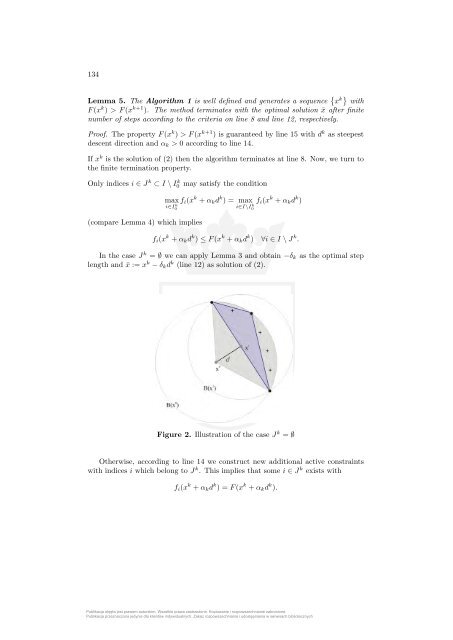PDF-file - Technische Universität Dresden
PDF-file - Technische Universität Dresden
PDF-file - Technische Universität Dresden
You also want an ePaper? Increase the reach of your titles
YUMPU automatically turns print PDFs into web optimized ePapers that Google loves.
134<br />
Lemma 5. The Algorithm 1 is well defined and generates a sequence { x k} with<br />
F (x k ) > F (x k+1 ). The method terminates with the optimal solution ¯x after finite<br />
number of steps according to the criteria on line 8 and line 12, respectively.<br />
Proof. The property F (x k ) > F (x k+1 ) is guaranteed by line 15 with d k as steepest<br />
descent direction and α k > 0 according to line 14.<br />
If x k is the solution of (2) then the algorithm terminates at line 8. Now, we turn to<br />
the finite termination property.<br />
Only indices i ∈ J k ⊂ I \ I k 0 may satisfy the condition<br />
(compare Lemma 4) which implies<br />
max f i (x k + α k d k ) = max f i (x k + α k d k )<br />
i∈I0<br />
k i∈I\I0<br />
k<br />
f i (x k + α k d k ) ≤ F (x k + α k d k ) ∀i ∈ I \ J k .<br />
In the case J k = ∅ we can apply Lemma 3 and obtain −δ k as the optimal step<br />
length and ¯x := x k − δ k d k (line 12) as solution of (2).<br />
Figure 2. Illustration of the case J k = ∅<br />
Otherwise, according to line 14 we construct new additional active constraints<br />
with indices i which belong to J k . This implies that some i ∈ J k exists with<br />
f i (x k + α k d k ) = F (x k + α k d k ).<br />
Publikacja objęta jest prawem autorskim. Wszelkie prawa zastrzeżone. Kopiowanie i rozpowszechnianie zabronione.<br />
Publikacja przeznaczona jedynie dla klientów indywidualnych. Zakaz rozpowszechniania i udostępniania w serwisach bibliotecznych
















